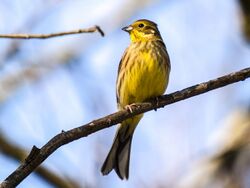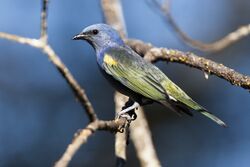Biology:Emberizoidea
| Emberizoids | |
|---|---|

| |
| Yellowhammer (Emberiza citrinella) | |

| |
| Golden-chevroned tanager (Thraupis ornata) | |
| Scientific classification | |
| Domain: | Eukaryota |
| Kingdom: | Animalia |
| Phylum: | Chordata |
| Class: | Aves |
| Order: | Passeriformes |
| Infraorder: | Passerida |
| Superfamily: | Emberizoidea Vigors, 1831 |
| Type species | |
| Emberiza citrinella | |
| Families | |
Emberizoidea is a superfamily of passerines that are referred to as the New World nine-primaried oscines that includes majority of endemics which are exclusive to the New World. Nearly 892 species belong to this group as it includes buntings, American sparrows, the New World blackbirds, the parulid warblers, the cardinals, and the tanagers.
Evolution
The group originated after a rapid speciation event in North America after arriving from Eurasia via Bering strait during the Miocene epoch. Two groups from within the emberizoids diversified further in the Neotropics where one clade comprising several small Caribbean endemic species and the other, the tanager-cardinal group, in South America. Another two families, the Emberizidae (buntings) and the Calcariidae (longspurs and snow buntings), returned to Eurasia and colonized.[1]
Taxonomy
The interrelationships among the emberizoids has been a source of contention as several genera have been shifted around in many phylogenetic studies. The cladogram of the emberizoids shown below is primarily based on the analysis of Carl Oliveros and colleagues published in 2019.[2][lower-alpha 1]
| ||||||||||||||||||||||||||||||||||||||||||||||||||||||||||||||||||||||||||||||||||||||||||||||||||||
The study considered Spindalidae and Nesospingidae to both be part of Phaenicophilidae, and Icteriidae as being a part of Icteridae, but they are shown as distinct in this tree. In addition, while Teretistridae was not analyzed in the study, previous studies indicated them as being allied with Zeledoniidae.[2]
References
- ↑ 1.0 1.1 Barker, F. K.; Burns, K. J.; Klicka, J.; Lanyon, S. M.; Lanyon, I. J. (2014). "New insights into New World biogeography: An integrated view from the phylogeny of blackbirds, cardinals, sparrows, tanagers, warblers, and allies.". The Auk: Ornithological Advances 132 (2): 333–348. doi:10.1642/AUK-14-110.1. https://academic.oup.com/auk/article/132/2/333/5149039.
- ↑ 2.0 2.1 Oliveros, C.H. (2019). "Earth history and the passerine superradiation". Proceedings of the National Academy of Sciences of the United States 116 (16): 7916–7925. doi:10.1073/pnas.1813206116. PMID 30936315.
- ↑ Kuhl, H.; Frankl-Vilches, C.; Bakker, A.; Mayr, G.; Nikolaus, G.; Boerno, S.T.; Klages, S.; Timmermann, B. et al. (2020). "An unbiased molecular approach using 3′-UTRs resolves the avian family-level tree of life". Molecular Biology and Evolution 38: 108–127. doi:10.1093/molbev/msaa191. PMID 32781465.
- ↑ Klicka, J.; Johnson, K.P.; Lanyon, S.M. (2000). "New World nine-primaried oscine relationships: constructing a mitochondrial DNA framework". The Auk 117 (2): 321–336. doi:10.1093/auk/117.2.321.
Notes
- ↑ A 2020 study by Heiner Kuhl and colleagues omitted Rhodinocichlidae, Calyptophilidae and Phaenicophilidae but obtained a similar phylogeny for the remaining families.[3] Earlier studies using more limited DNA sequence data obtained different relationships between the families.[4][1]
Wikidata ☰ Q105617078 entry
 |

